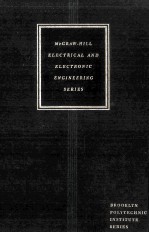

Introductory System Analysis Signals and Systems in Electrical EngineeringPDF电子书下载
- 电子书积分:20 积分如何计算积分?
- 作 者:William A.Lynch and John G.Truxal
- 出 版 社:
- 出版年份:1961
- ISBN:
- 页数:0 页
Chapter 1.The Language of Signals and Systems 1
1-1.The Cause-and-effect Pattern 1
1-2.A Radio Broadcast System 2
1-3.Automatic Systems 5
1-4.A System to Stabilize a Ship 7
1-5.Signals and Systems 11
Problems 12
Chapter 2.Signals 13
2-1.Signals:Physical and Analytical 13
2-2.Exponential Signals 15
2-3.Negative Real Values of s 16
2-4.Positive Real Values of s 22
2-5.Complex Numbers 22
2-6.Imaginary Values of s 27
2-7.Complex Values of s 35
2-8.Zero Value of s 39
2-9.Integrals and Derivatives of the Unit Step Function 40
2-10.The s Plane 49
Problems 52
Chapter 3.Models for Mechanical Systems 65
3-1.The Nature of Analysis 65
3-2.Mechanical System Models 67
3-3.The Ideal Mass Element 67
3-4.The Ideal Spring Element 69
3-5.The Ideal Damper Element 72
3-6.Summary:Ideal Elements 75
3-7.Nature of Linear Models 75
3-8.Energy,Work,and Power 80
3-9.Ideal Source Elements 83
3-10.Through and Across Variables 86
3-11.Construction of the Circuit Diagram 89
3-12.Derivation of the Circuit Equations 95
3-13.Rotational Systems 99
3-14.Combined Systems 110
3-15.Units 115
3-16.Concluding Comments 118
Problems 121
Chapter 4.Electrical Systems 135
4-1.Elements of an Electric Circuit 135
4-2.Gravitational Phenomena 141
4-3.Electrostatic Phenomena 150
4-4.Magnetic Phenomena 160
4-5.Electrical Energy Dissipation 170
4-6.Node Equations for Electric Circuits 171
4-7.Loop Equations 178
4-8.Practical Sources 181
4-9.Summary 186
Problems 192
Appendix 4-1.Examples of Node Equations 201
Appendix 4-2.The Cathode-ray Tube 206
Chapter 5.The Response of Simple Electric Circuits 216
5-1.Characteristics of Electrical Networks 216
5-2.The Nature of the Circuit Equations 220
5-3.The Dynamics of Undriven Systems 228
5-4.Unit-impulse Excitation 237
5-5.Response to Exponential Excitation 242
5-6.Network Interpretation of Driving Signals 247
5-7.Some Special Cases 251
5-8.Further Relations between Transfer Functions and Time Responses 253
5-9.Initial Conditions Represented by Equivalent Sources 257
Problems 269
Appendix 5-1.Solution of Simultancous Algebraic Equations 279
Appendix 5-2.Partial-fraction Expansions 280
Chapter 6.The Transfer Function 285
6-1.The Forced Component of the Response 285
6-2.Calculation of T(s) 287
6-3.Sinusoidal Excitation 292
6-4.Pole and Zero Constellations 295
6-5.Stability 297
6-6.Sinusoidal Frequency Response 298
6-7.Geometry of the s Plane 303
6-8.Exploiting s-plane Geometry 312
6-9.Resonance Phenomena 320
6-10.Quality Factor 324
6-11.Specific Resonant Systems 327
6-12.Adjustable-parameter Networks 333
Problems 343
Chapter 7.The Elements of Analog Simulation and Analog Computers 355
7-1.Types of Automatic Computers 355
7-2.A Symbolism for Analog Simulation 359
7-3.The Essence of Analog Simulation 362
7-4.Signal-flow Graphs—A Shorthand Analog Symbolism 365
7-5.Systematic Graphing Techniques 369
7-6.Graphing Differential Equations 372
7-7.Electronic Analog Computers 379
7-8.The Algebra of Signal-flow Graphs 397
Problems 409
Chapter 8.Summary Illustrative Example 422
8-1.Introduction 422
8-2.Statement of the Problem 422
8-3.Steps in Analysis 423
8-4.Signal Approximation 424
8-5.Formulation of Dynamie Equations 425
8-6.Determination of the Transfer Function 427
8-7.Response to Step of Amplitude 5 428
8-8.Response to the Square Pulse 431
8-9.Response to the Sinusoidal Pulse 433
8-10.Comparison of the Two Responses 437
8-11.Simulation Techniques 437
8-12.Analog-computer Simulation 439
8-13.Concluding Remarks 445
- 《一个数学家的辩白》(英)哈代(G.H.Hardy)著;李文林,戴宗铎,高嵘译 2019
- 《莎士比亚戏剧精选集》(英)威廉·莎士比亚(William Shakespeare)著 2020
- 《数据失控》(美)约翰·切尼-利波尔德(John Cheney-Lippold)著 2019
- 《皆大欢喜》(英)威廉·莎士比亚(William Shakespeare)著 2019
- 《深奥的简洁》(英)约翰·格里宾(John Gribbin)著 2020
- 《铸造手册大全 金属铸造工艺、冶金技术和设计 第6册 熔炼·造型·铸造·凝固》John Campbell主编 2018
- 《论自由》(英)约翰·穆勒(John Stuart Mill)著 2019
- 《DETECTION AND SPECTROMETRY OF FAINT LIGHT》JOHN MEABURN
- 《治理、政治与国家=GOVERNANCE》POLITICS AND THE STATE
- 《暗黑之门 历任首相主导下的英国情报史话=SPIES》SECRET INTELLIGENCE AND BRITISH PRIME MINISTERS
